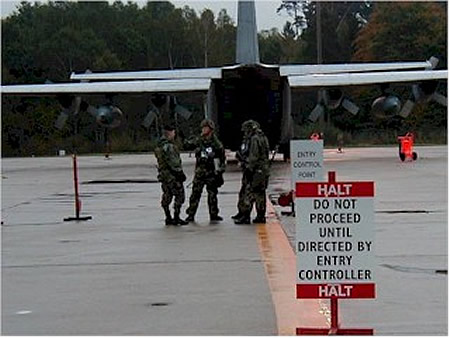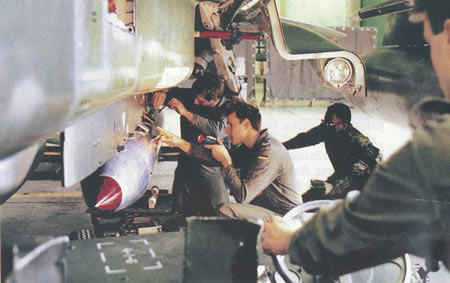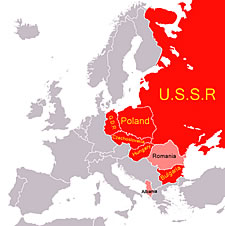 |
| Security personnel monitor nuclear weapons transport at German air base. Image: USAF |
.
By Hans M. Kristensen
The new German government has announced that it wants to enter talks with its NATO allies about the withdrawal of the remaining U.S. nuclear weapons from Germany.
The announcement coincides with the Obama administration’s ongoing Nuclear Posture Review, which is spending an unprecedented amount of time pondering the “international aspects” of to what extent nuclear weapons help assure allies of their security.
Germany and many other NATO countries apparently don’t want to be protected by U.S. forward-deployed tactical nuclear weapons, which they see as a relic of the Cold War that locks NATO in the past and prevents it’s transition to the future.
Current Deployment
The U.S. Air Force currently deploys approximately 200 B61 nuclear bombs at six bases in five NATO countries (see Table 1). The weapons are the last remnant of a vast force of more than 7,000 tactical nuclear weapons that used to clutter bases in Europe during the Cold War as a defense against the Soviet threat and the Warsaw Pact’s large conventional forces.
|
Table 1: |
 |
| Approximately 200 U.S. nuclear bombs are currently deployed at six bases in five European countries. Click image to download larger table. |
.
The bombs are scattered among 87 individual aircraft shelters where they are stored in underground vaults. Although well protected, this widespread deployment contrasts normal U.S. nuclear weapons security procedures that favor consolidation at as few locations as possible.
An Air Force investigation concluded in 2008 that “most” sites in Europe did not meet U.S. security requirements. NATO officials publicly dismissed the conclusion, and a visit by a team from the U.S. government apparently found issues but nothing alarming.
Consolidation Versus Withdrawal
Rumors have circulated for several years about plans to consolidate the remaining weapons from the current six bases to one or two bases. The plans would either terminate the Cold War arrangement of non-nuclear NATO countries being assigned strike missions with U.S. nuclear weapons, or move the weapons to U.S. bases with the promise that they could be returned if necessary.
Consolidation has occurred frequently since the end of the Cold War: withdrawal from Turkish national bases Akinci and Balikesir in 1995; withdrawal from German national bases Memmingen and Norvenich in 1996; withdrawal from Greek national base Araxos in 2001; withdrawal from Ramstein in Germany in 2005 ; withdrawal from Lakenheath in England in 2006. Another round of consolidation would just be another slow step toward the inevitable: withdrawal from Europe.
Consolidation of the remaining nuclear bombs to the two U.S. southern bases at Aviano in Italy and Incirlik in Turkey would be problematic for two reasons. First, Turkey does not allow the U.S. Air Force to deploy the fighter-bombers to Incirlik that are needed to deliver the bombs if necessary, and has several times restricted U.S. deployments through Turkey into Iraq. Given that history, and apparent doubts about Turkey’s future direction, is nuclear deployment in Turkey a credible posture? Second, absent a fighter wing deployment to Incirlik, Aviano carries the overwhelming burden of conventional air operations on the southern flank of NATO, operations that are already burdened by the nuclear addendum and would further be so by a decision to consolidate the nuclear mission at the base.
An End to NATO Nuclear Strike Mission
The German policy to seek withdrawal of nuclear weapons from Büchel Air Base essentially means – if implemented – the unraveling of the NATO nuclear strike mission, whereby non-nuclear NATO countries equip and train their air forces to deliver U.S. nuclear weapons. Germany shares this mission with Belgium, Italy, and the Netherlands, while Greece and Turkey opted out in 2001.
|
Table 1: |
 |
| German personnel attach a U.S. B61 nuclear bomb shape to a German Tornado fighter-bomber under supervision of U.S. personnel. As a signatory to the NPT Germany has pledged not to receive nuclear weapons, yet, as this picture illustrates, is preparing its military to do so anyway. Image: German Ministry of Defense/Der Spiegel |
.
The mission is highly controversial because these countries as signatories to the nuclear Non-Proliferation Treaty (NPT) have all pledged not to receive nuclear weapons: “undertakes not to receive the transfer from any transferor whatsoever of nuclear weapons or other nuclear explosive devices or of control over such weapons or explosive devices directly, or indirectly.” Yet that’s precisely what the NATO strike mission entails: peacetime preparations for direct transfer of nuclear weapons and control over such weapons in times of war.
The mission is clearly inconsistent with if not the letter then certainly the spirit of the NPT. The arrangement was tolerated during the Cold War but is incompatible with nonproliferation policy is the 21st century.
Real-World Security Commitments
Germany is one of the “30-plus” allies and friends that some have argued recently need to be protected by nuclear weapons to prevent them from developing their own nuclear weapons. It has even been suggested that extended deterrence necessitates equipping the F-35 Joint Strike Fighter with nuclear capability.
Yet high-level officials in both the White House and the Pentagon have already concluded that the United States no longer needs to deploy nuclear bombs in Europe to meet its security obligations to NATO. Those security obligations today have very little to do with nuclear weapons and extended deterrence is predominantly served by non-nuclear means. The limited role nuclear weapons still serve can adequately be fulfilled by long-range weapon systems just as they have been in the Pacific for 17 years. Whether the ongoing Nuclear Posture Review will reflect those views will be seen in February 2010 when the review is completed.
|
Figure 2: |
 |
| The U.S. nuclear bombs were deployed in Europe to defend NATO against a conventional attack from the Warsaw Pact, a threat that has long-since disappeared. |
Regardless, Germany apparently does not want to be protected by U.S. nuclear weapons deployed in Europe. Neither does Belgium, where the parliament unanimously has requested nuclear bombs be withdrawn. Dutch officials privately say that they see no need for the deployment either. In fact, in all of the countries where nuclear weapons are deployed, an overwhelming majority of the public favors withdrawal. Turkey – one of the countries said by some to oppose withdrawal – has the highest public support for withdrawal of any of the countries that currently store nuclear weapons. In the long run this is a serious challenges for NATO; that its nuclear posture is so clearly out of sync with public opinion.
The biggest challenge seems to be to convince Poland and Turkey that withdrawal will not undermine the U.S. security commitment. Poland is worried about Russia; Turkey about Iran. But tactical nuclear weapons were the Cold War way of addressing such concerns. What’s needed now is focused diplomacy, stewardship, and reaffirmation of non-nuclear arrangements to convince these countries that the nuclear bombs that were deployed in Europe to defend NATO against a conventional attack from the Warsaw Pact can now finally be withdrawn.
The previous two German governments also favored withdrawal but did little to push the issue. Whether the new government will be any different will be put to the test during NATO’s ongoing revision of its Strategic Concept scheduled for completion in 2010.
This publication was made possible by a grant from Carnegie Corporation of New York and Ploughshares Fund. The statements made and views expressed are solely the responsibility of the author.
The FY2026 National Defense Authorization Act (NDAA) paints a picture of a Congress that is working to both protect and accelerate nuclear modernization programs while simultaneously lacking trust in the Pentagon and the Department of Energy to execute them.
While advanced Chinese language proficiency and cultural familiarity remain irreplaceable skills, they are neither necessary nor sufficient for successful open-source analysis on China’s nuclear forces.
Satellite imagery has long served as a tool for observing on-the-ground activity worldwide, and offers especially valuable insights into the operation, development, and physical features related to nuclear technology.
This report outlines a framework relying on “Cooperative Technical Means” for effective arms control verification based on remote sensing, avoiding on-site inspections but maintaining a level of transparency that allows for immediate detection of changes in nuclear posture or a significant build-up above agreed limits.